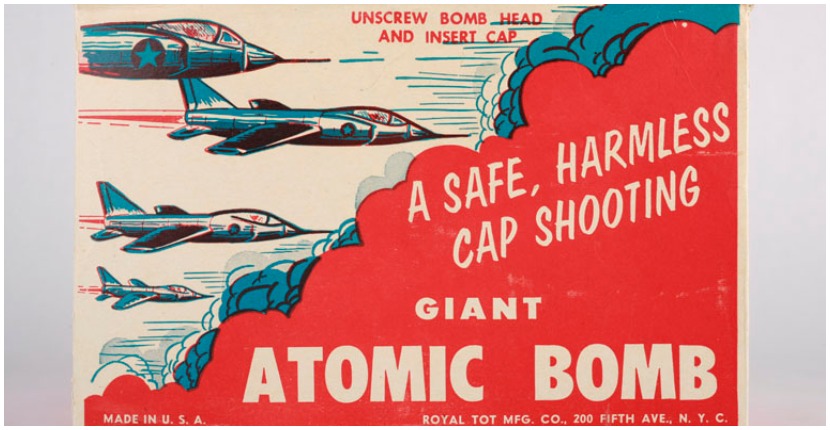Many toys reflect the times in which they were popular and in the 1950s, atomic toys were just that. The ushering in of the computer age saw the creation of Simon, a light up memory game, the Atari 2600 game console, and the Nintendo Game Boy. In the 1950s, however, technology was geared toward the newly discovered atomic energy and nuclear bomb testing—and toys followed suit.
The first nuclear test took place on July 16, 1945 in White Sands, New Mexico, sixty five miles northwest of Las Vegas. People were unaware of the dangers of radiation and actually rushed to Las Vegas to party and watch the mushroom clouds. No one in the vicinity was evacuated, and soldiers were watching from nearby. After this, the public couldn’t get enough of everything “atomic” and the fad was on.
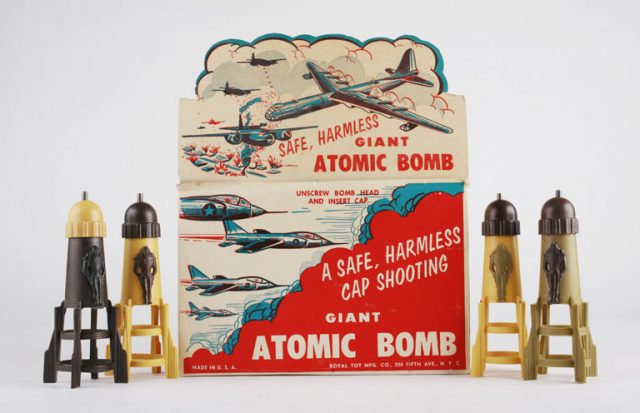
Some of the toys made during this time reflected the naivety about radiation. According to orau.org, one of the first toys was the Porter Atomic Energy Kit that came with two glass vials: one with uranium ore and the other with a “uranium chemical”. It also included a radioactive detection screen and a brochure, The Story of Atomic Energy, as well as a spinthariscope, a device which shows the occurrence of alpha particles by flashes on a fluorescent screen.
The American Basic Science Club offered the Atomic Energy Lab from 1957 until 1973 and it included a spinthariscope, a cloud chamber, a radioactive detection screen, an electroscope, and radium and uranium ore.
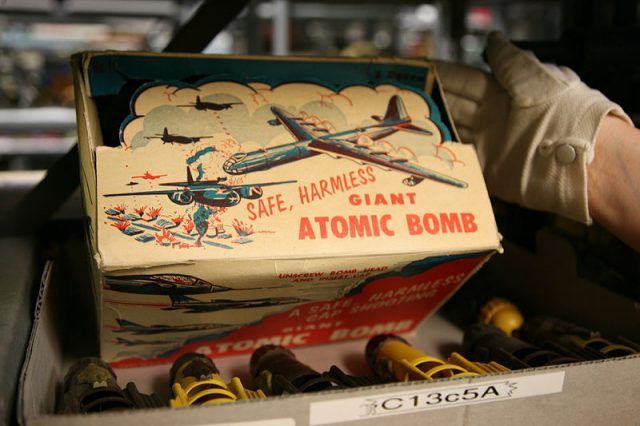
In 1950, The Gilbert Hall of Science produced a U-238 Atomic Energy Lab complete with “four types of uranium ore, a beta-alpha source, a pure beta source, a gamma source, a spinthariscope, a cloud chamber with its own short-lived alpha source, an electroscope, a Geiger counter, a manual, a comic book, Dagwood Splits the Atom [yes, that’s Blondie’s husband], and a government manual titled Prospecting for Uranium.” It sold for fifty dollars—comparable to five hundred dollars today. Owners got a special coupon to order more of the radioactive substances due to the possible short life of the materials. Seen on A.C. Gilbert Heritage Society, the ad for the toy states it is “Completely Safe And Harmless!”
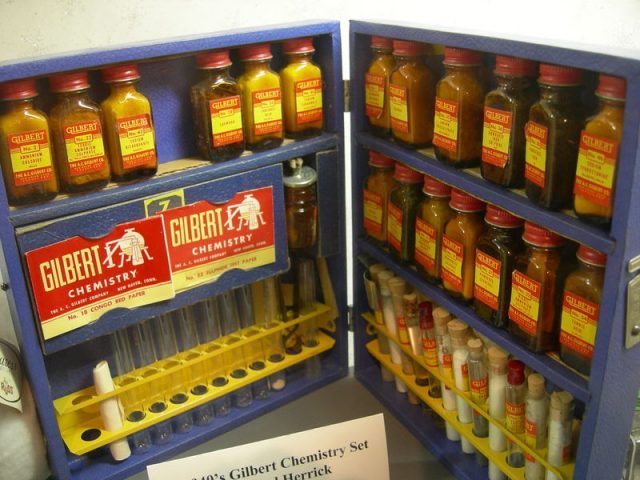
Moving down to less dangerous toys, in 1955, an Atomic Geiger Counter was manufactured by Bell Products and sold with a mining license, claim stake, prospectus, and registration card, but it only detected items made of iron.
Tin toy guns with a futuristic design were made in Japan in the late 1950s to early 1960s and marketed with such names as the Atomic Disintegrator and the Buck Rogers Atomic Pistol. They often used caps and had a transparent window which showed sparks when one pulled the trigger.
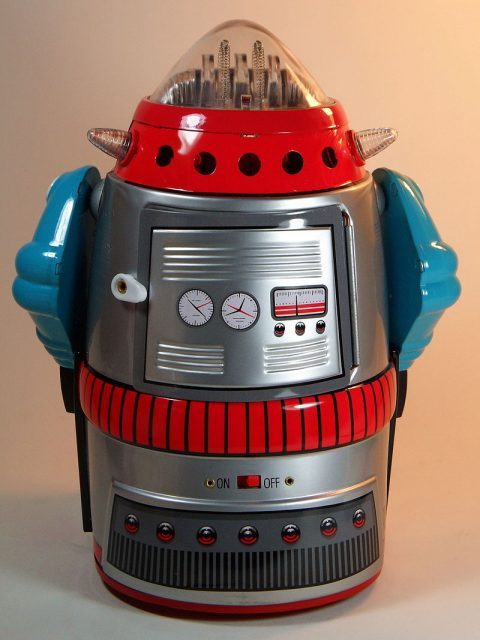
Games got into the act with the Nuclear War card game which was described as a “comical cataclysmic card game of global destruction”. The goal was to have your country be the last one standing after the big one hit.
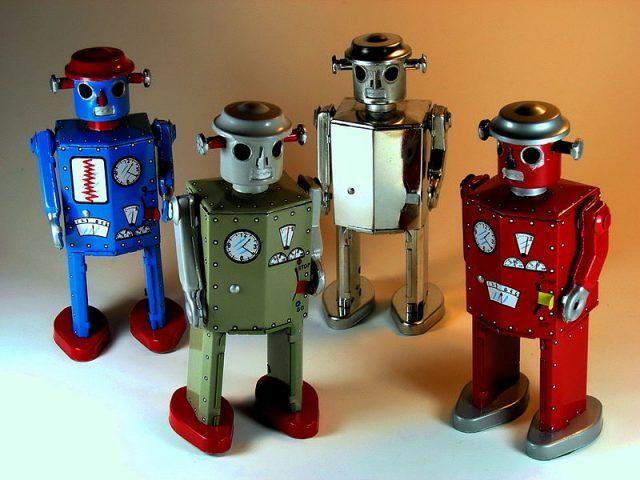
In the board game category, oaru.org tells about the Uranium board game created by Saalfield Publishing in Akron, Ohio. In this game, the first person to discover uranium and make it to the Claim Office wins. BoardGameGeek shows Uranium Rush, invented by Gardner Games which was chosen as one of the outstanding toys for 1955. It was electric and allowed the players to test if their mine claim was any good. A small round tube with wires coming out the top called a “Geiger counter” touched the tip of a small metal circle around the mine and if it buzzed and lit up your mine was good.
Comic books were extremely popular in the 1950s and 1960s so comic book publishers came up with Atomic Mouse who took U-235 pills to gain super strength. In 1955, Atomic Rabbit ate carrots grown in uranium soil for his superpowers. Inside the Atom was an educational comic book that touted nuclear power.
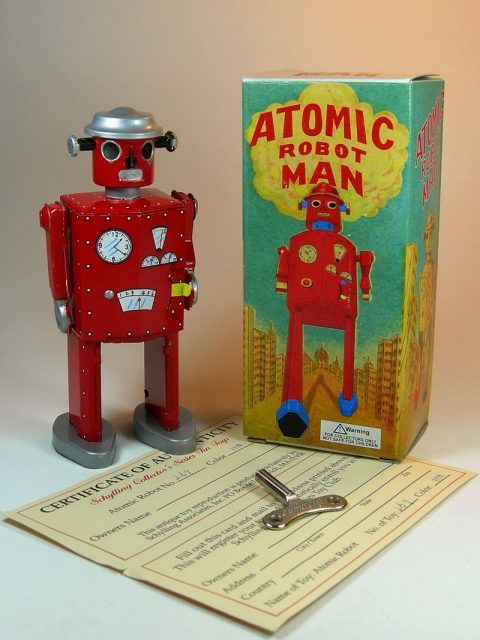
In the 1962 Sears Christmas catalog there was even a doll house that featured a fallout shelter.
In 1959, Revell sold a very detailed Westinghouse Atomic Power Plant model kit which included a nuclear reactor vessel, circulating pumps, steam generators, power lines, and towers with an electrical substation and much more. A small booklet, A New World of Atomic Power, by Dr. William E. Shoupp of Westinghouse was also included. This item is sometimes for sale on Ebay.
Gradually, the government realized that the effects of nuclear fallout could cause cancer, and, in 1962, above ground testing was discontinued but underground testing went on until 1992. Studies done in 1990 showed nuclear fallout drifted in the wind and affected the states of Nevada, Idaho, Utah, Arizona, Oregon, and Washington, and cancer rates rose sharply from 1950 to 1980.
Related Article: Uranium in the Plates? Our Ancestors Dined off of Radioactive Tableware
The soldiers who were present at the tests have had an increased mortality rate from leukemia, nasal cancer, and prostate cancer. The National Association of Atomic Veterans was founded in the 1990s to help with recognition of the health concerns of the atomic veterans and to assist those who have fallen ill because of radiation. The NAAV points out that what many people don’t realize is that people didn’t have to be exposed to the radiation to be affected by it. Radiation settled in the grass, and, when cows ate the tainted grass, it passed into their milk and was delivered to the person who drank the milk. The poison collected in the thyroid glands and the chance of thyroid cancer dramatically rose. The National Association of Atomic Veterans is a non-profit organization and survives due to volunteering and donations.
